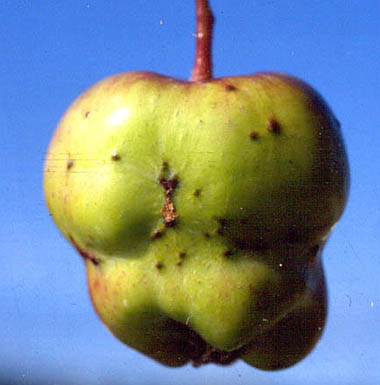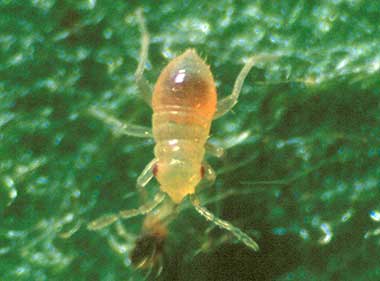Mullein Bug (Campylomma)
General Description
Mullein bug, also known as campylomma, is an effective predator of some important tree fruit pests such as apple leaf midge larvae, pear psylla nymphs, mites, and aphids. Unfortunately it is also a pest of some varieties of apple in the spring.
Hosts
Apple, pear, rose, Saskatoon berry, mullein, potato, corn
Damage
Fruit - Feeding by nymphs produces a corky pustule 1-2 mm in diameter on the skin of young fruitlets during a 3-week period starting at bloom or early petal-fall (Fig. 1).
 |
| Figure 1. Apple damaged by mullein bug feeding. (BCMA) |
On apple fruitlets the tissue around feeding punctures fails to grow normally, resulting in misshapen fruit. The feeding punctures distort the fruit. Apple fruit up to 12 mm in diameter are most susceptible to injury. Injured pear fruitlets retain normal shape and the pustules do not expand so that one to a few pustules may pass unnoticed at harvest.
Identification
Nymph - 0.5-2.5 mm long, with pointed head and red eyes; fast moving; body colourless, pale green, tan, reddish or brown, depending on food (Figs. 2 & 3).
 |
|
| Figure 2. Mullein bug nymph feeding on a mite. (AA-FC) | Figure 3. Mullein bug nymph on beating board. (BCMA) |
Adult - Oval, winged, 3 mm long, light green to tan (Fig. 4).
.jpg) |
| Figure 4. Adult mullein bug. (Tristan Bantock) |
Life History
During September and October females lay eggs in the bark of young twigs on apple and pear trees and on Saskatoon berry and wild rose bushes. Overwintered eggs begin to hatch near bloom. Nymphs feed mainly on small insects and mites, but will feed on plant sap when prey is scarce. First generation adults appear in June. Most of the adults migrate to annual plants to feed and produce one or two more generations during July, August and September. A small population may remain on apple and pear trees to reproduce during the summer if there are enough mites, aphids or pear psylla to attract them. In the fall, adults migrate back to apple and pear and other woody plants to feed and lay eggs. High populations of mites and aphids in the fall have sometimes been associated with high populations of mullein bug in an orchard the following spring.
Monitoring
Use a beating tray in the spring to determine if mullein bug populations are high enough to cause damage. Because distribution of this insect tends to be uneven within an orchard, it is important to sample thoroughly, especially where damage has occurred in the past. Sample susceptible apple and pear blocks at the rate of 50 taps (a tap = 3 solid limb beats) per hectare and calculate the average number of nymphs per tap for each block. Begin sampling at pink of apple and continue through bloom and every 3 days after bloom until hatch is completed. Carefully check rows adjacent to pear blocks to detect migration from the pears where mullein bugs are encouraged for biological control of pear psylla.
Because sampling efficiency varies with tapping style used, growers and advisors should develop their own treatment levels. Very susceptible varieties may need a spray at levels as low as 1 per tap, while less susceptible varieties may need a spray at levels of 4-15 per tap. Gala, Sunrise, Golden Delicious and spur Red Delicious apples are very susceptible; Braeburn, Elstar, Red Rome, Spartan, Jonagold, Empire and non-spur Red Delicious apples and Bartlett pear are moderately susceptible. McIntosh, Granny Smith and Fuji apples and Anjou pear are tolerant to mullein bug.
A pheromone-baited trap is commercially available to monitor blocks of susceptible fruit varieties for returning adult mullein bugs in September and October. Research in conventional orchards in the Okanagan has found that high numbers of adults in the fall will result in high numbers of nymphs the following spring. By monitoring adults in the fall, growers can determine which blocks are potentially at risk of mullein bug damage.
Management
Cultural Control
Removal of mullein in and around the orchard may be helpful. Avoid large plantings of corn or potatoes in or near orchards.
Chemical Control
Apply Alias, Admire , Cormoran, Vayego SC200 (suppression only) or Calypso at early petal-fall if needed once the bees are no longer foraging in the block. Calypso is the least harmful to bees (see Bee Poisoning in Horticulture/Varieties and Pollination). Do not apply Alias, Admire or Calypso more than twice per season for all registered pests. See the precautions regarding use of Alias, Admire and Calypso under apple aphid and mite control.
